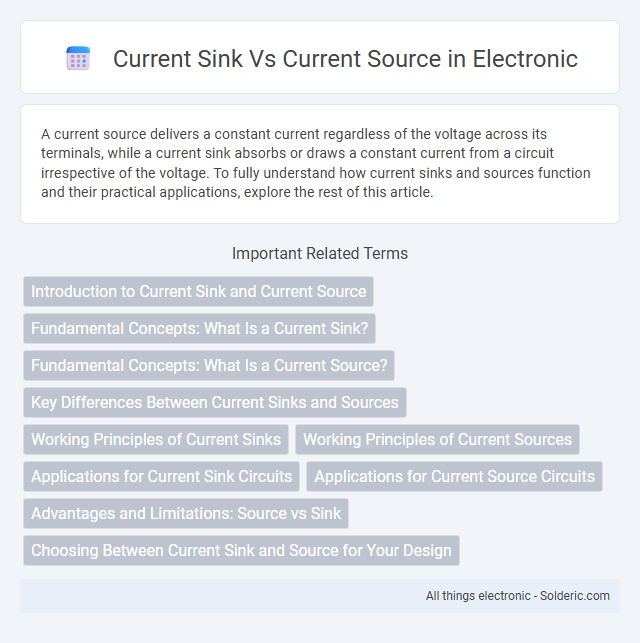A current source delivers a constant current regardless of the voltage across its terminals, while a current sink absorbs or draws a constant current from a circuit irrespective of the voltage. To fully understand how current sinks and sources function and their practical applications, explore the rest of this article.
Comparison Table
| Feature | Current Sink | Current Source |
|---|---|---|
| Definition | Device that absorbs or draws current from a load. | Device that supplies or delivers current to a load. |
| Current Direction | Current flows into the device. | Current flows out of the device. |
| Typical Application | Used to pull signals low or ground a load. | Used to push signals high or power a load. |
| Example Components | Transistor configured as low-side switch, sinking LED current. | Transistor configured as high-side switch, sourcing LED current. |
| Voltage Level | Output node typically closer to ground potential. | Output node typically closer to positive supply voltage. |
| Usage in Digital Circuits | Pull-down resistors or sinking outputs for logic low. | Pull-up resistors or sourcing outputs for logic high. |
Introduction to Current Sink and Current Source
Current sinks and current sources are fundamental components in electronic circuits used to control the direction of current flow. A current source provides a constant current regardless of the voltage across it, while a current sink absorbs or draws a consistent current from the circuit. Understanding the differences between your current sink and source is essential for designing stable and efficient electronic systems.
Fundamental Concepts: What Is a Current Sink?
A current sink is an electronic component or circuit designed to absorb or draw a consistent current from a node, maintaining control over current flow within the system. It operates by providing a path to ground or a lower potential, effectively pulling current out of the circuit rather than supplying it like a current source. Understanding this fundamental concept helps you design circuits with precise current regulation for applications such as LED driving, sensor interfacing, and analog signal processing.
Fundamental Concepts: What Is a Current Source?
A current source is an electrical component or circuit that delivers a constant current regardless of the voltage across its terminals, ensuring stable current flow in various conditions. Unlike a current sink, which absorbs current, a current source actively pushes or supplies current into a circuit. Understanding this distinction helps you design and analyze circuits that require precise current control for optimal performance.
Key Differences Between Current Sinks and Sources
Current sinks withdraw current from a circuit node by providing a low-resistance path to ground, while current sources deliver a controlled current to the load regardless of voltage variations. The key differences include polarity: sinks draw current in, whereas sources push current out, and the dependency on voltage; sources maintain constant current despite voltage changes, sinks regulate current by adjusting the node voltage. Understanding these distinctions helps optimize your circuit design for desired current flow control and power management.
Working Principles of Current Sinks
Current sinks function by drawing a constant current from a circuit regardless of voltage changes, using a controlled transistor or operational amplifier to maintain steady current flow. They operate by adjusting the voltage across the sink to ensure the desired current level stays fixed, effectively acting as a variable resistor controlled by the output voltage. This precise regulation enables current sinks to provide stable current for applications such as LED driving, biasing transistors, and analog-to-digital conversion.
Working Principles of Current Sources
Current sources operate by delivering a constant current regardless of voltage variations across their terminals, using active components like transistors or operational amplifiers to maintain this steady flow. They function by adjusting their output voltage to ensure the specified current passes through the load, providing precise control for applications requiring stable current. Your electronic designs benefit from current sources when consistent current is critical, such as in LED driving or sensor excitation.
Applications for Current Sink Circuits
Current sink circuits are widely used in LED driver applications to maintain consistent brightness by regulating current flow regardless of voltage changes. They are essential in integrated circuits for biasing transistors in analog and digital circuits, ensuring stable operation and signal integrity. Your design will benefit from current sink circuits in sensor interfaces where precise current control enhances measurement accuracy.
Applications for Current Source Circuits
Current source circuits are widely used in applications such as LED drivers, where a constant current is crucial for consistent brightness and extended device lifespan. They serve in biasing transistors in analog circuits, ensuring stable operation independent of voltage variations. Your designs benefit from current source circuits in sensor interfaces and charging systems where precise current regulation is essential.
Advantages and Limitations: Source vs Sink
Current sources provide the advantage of delivering a consistent current regardless of the voltage across the load, making them ideal for applications requiring stable current control. Current sinks, on the other hand, offer efficient control by drawing current through the load, often simplifying circuit design and minimizing voltage drop issues. Your choice between source and sink depends on the specific needs for voltage stability, power efficiency, and circuit complexity in your application.
Choosing Between Current Sink and Source for Your Design
Choosing between a current sink and a current source depends on the specific requirements of your circuit design, including voltage compliance, load characteristics, and power dissipation. Current sinks are optimal for applications requiring precise current control with voltage references below the load, while current sources are preferred when supplying current with a stable voltage above the load. Careful consideration of load resistance, compliance voltage ranges, and thermal management ensures effective and reliable operation in your design.
current sink vs current source Infographic

 solderic.com
solderic.com